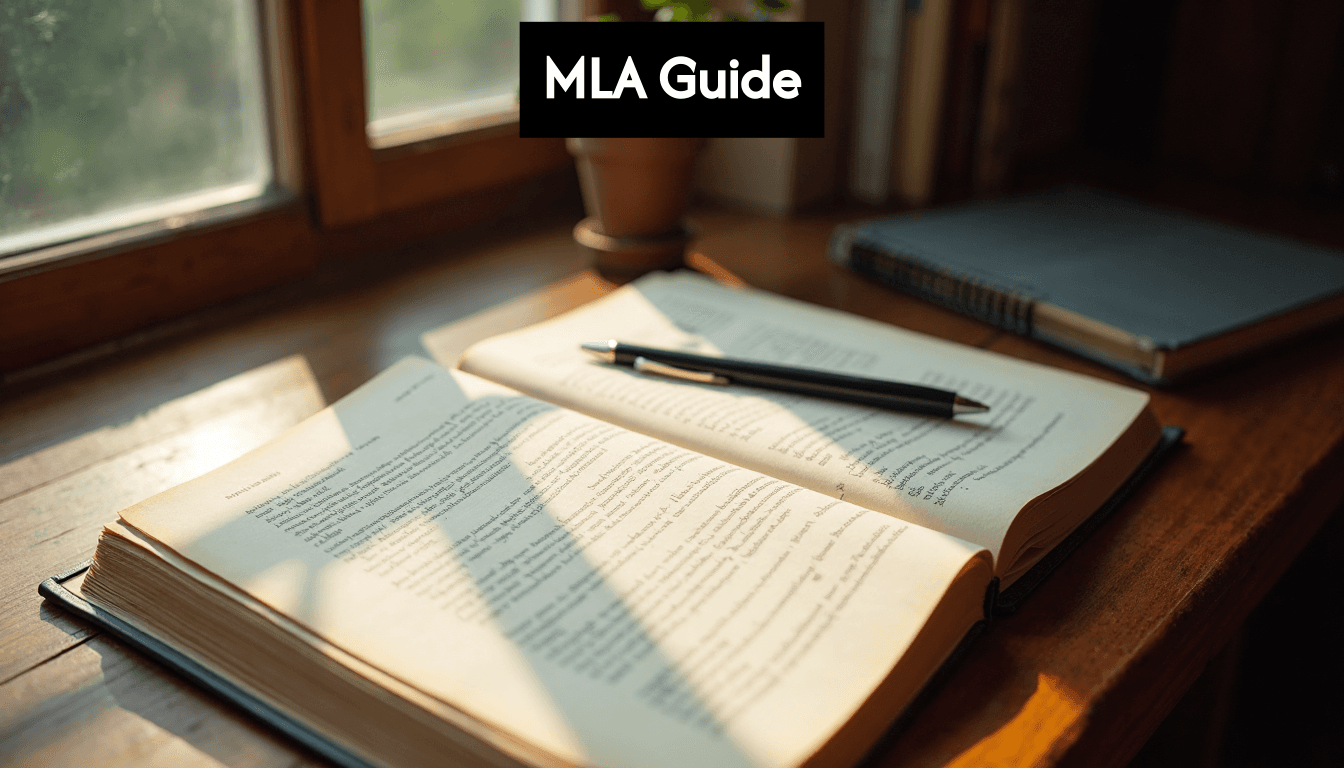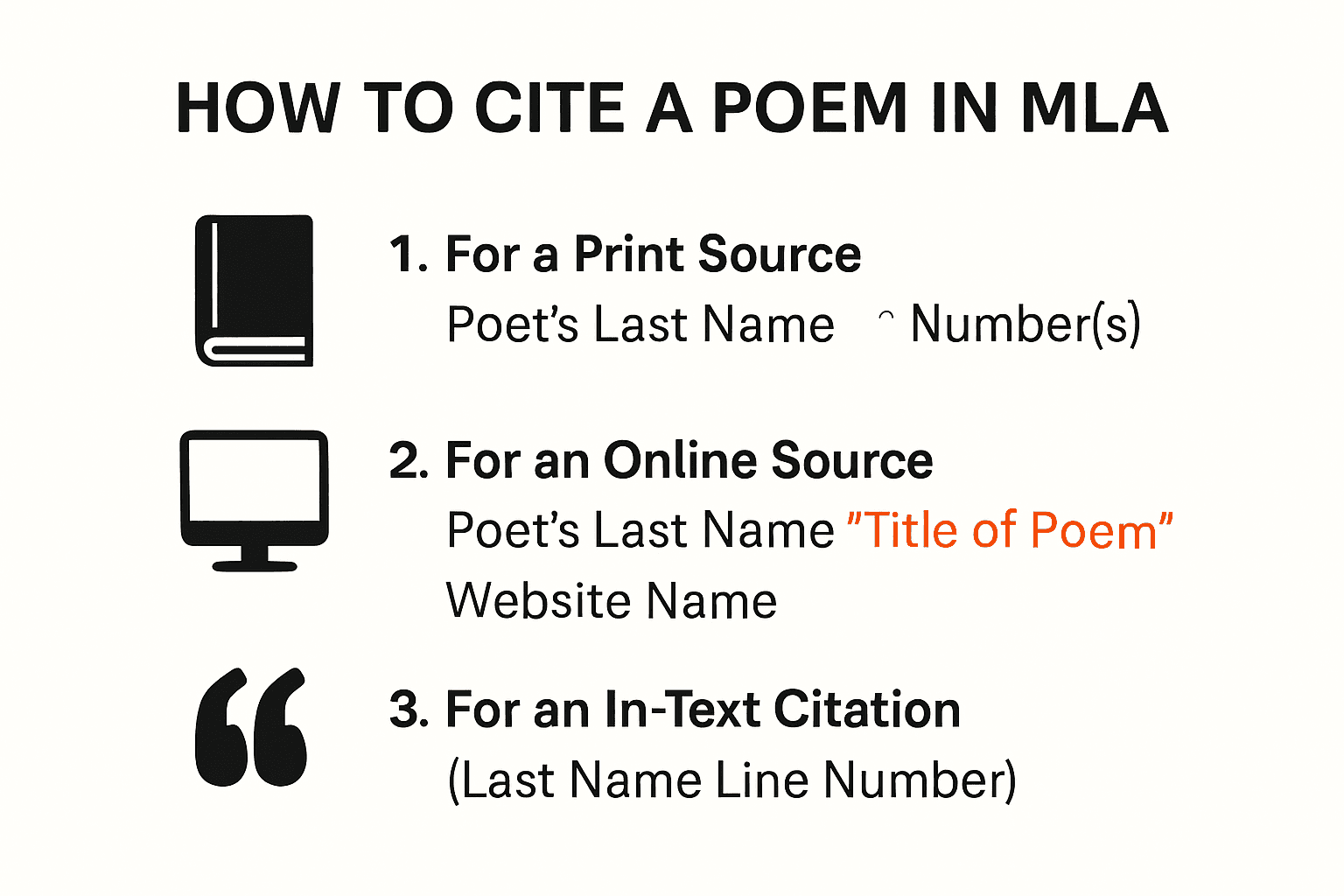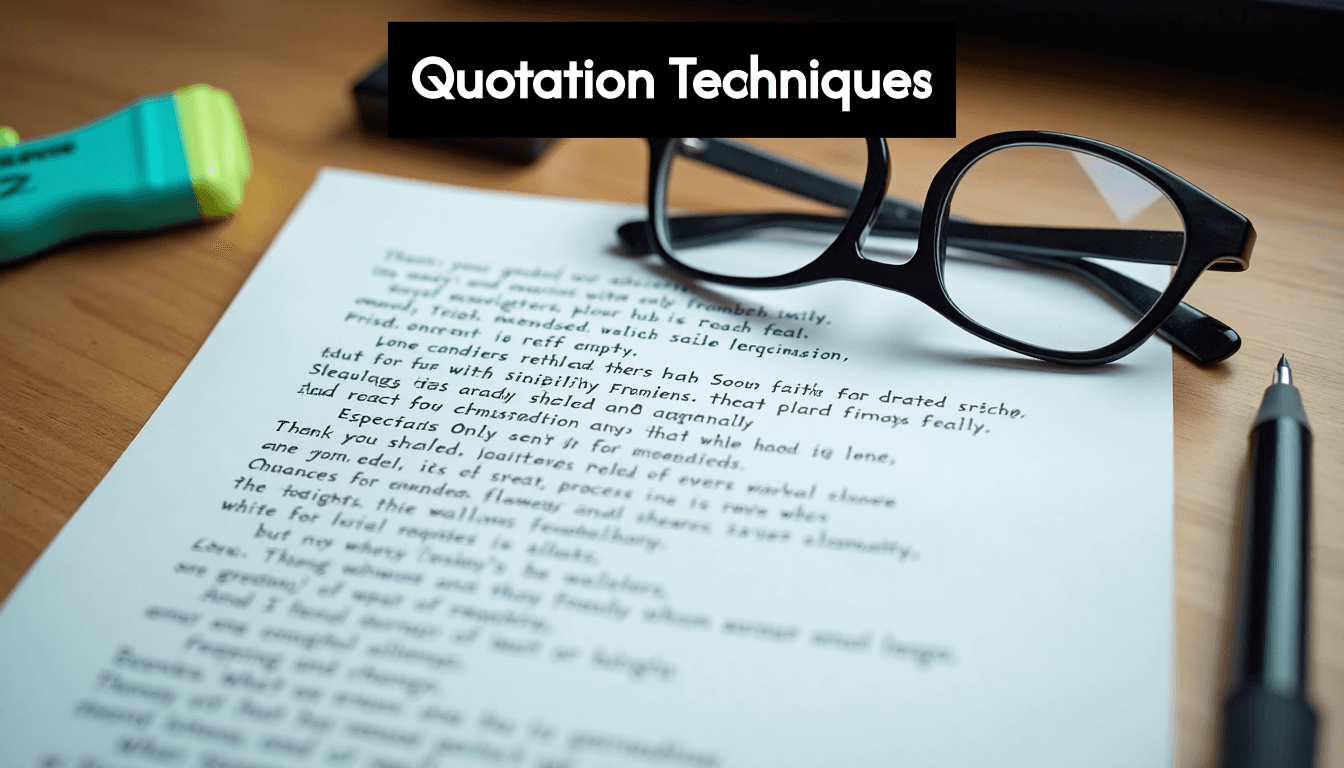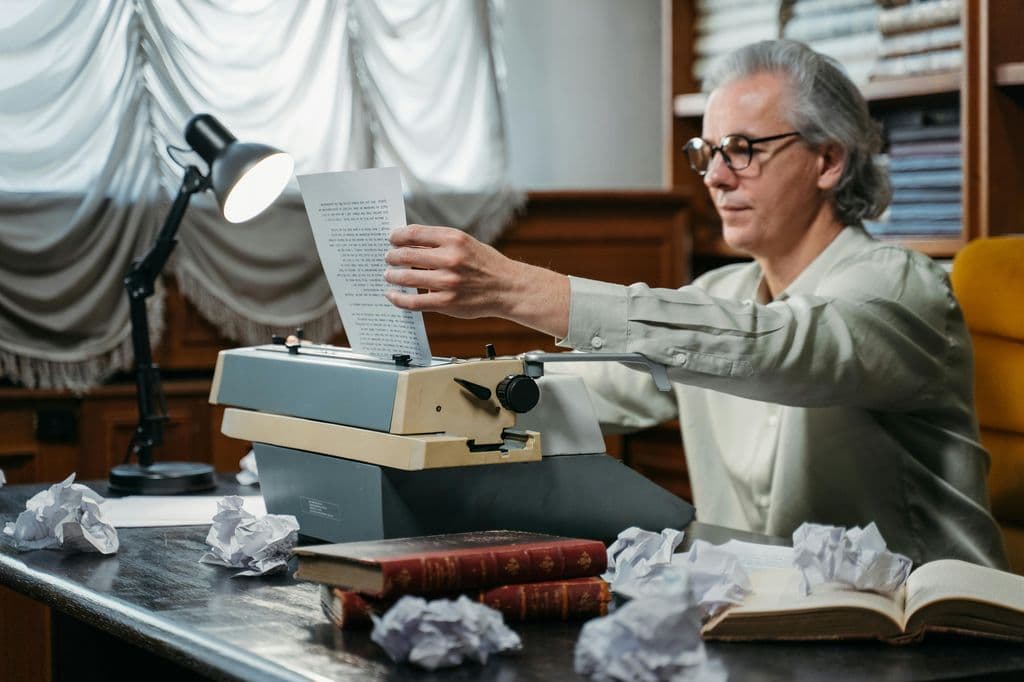Blog
Learning Materials
How to Cite and Quote a Poem in MLA (2025 Guide)
Updated: June 26, 2025

Citing poetry in MLA sounds simple, right? Think again. Pulling lines from poems demands careful attention to weird formatting rules that catch even advanced writers off guard. Here is the kicker: MLA treats a two-line poem quote entirely differently from a four-line excerpt, and misplacing a single forward slash can cost you vital accuracy points. Surprised? Most students miss the fact that online poems need extra information like URLs and access dates, not just a title and author. Find out how the latest MLA rules will change the way you handle every poem you quote.
Table of Contents
- Basic MLA Poem Citation Principles
- Citing Online And Print Poetry Sources
- In-Text Citation For Poems
- Short Poem Quotation Techniques
- Block Quote Formatting For Longer Poems
- Handling Complex Poetic Structures
- In-Text Citation Strategies For Poems
- Constructing Works Cited Entries
- Special Considerations For Complex Poetic Sources
- Frequent Citation Errors To Avoid
- Expert Strategies For Accurate Poem Citations
- Navigating Challenging Poetic Citation Scenarios
Quick Summary
| Takeaway | Explanation |
|---|---|
| MLA citation for poems requires attention to formatting. | For both short and long quotes, maintain original line breaks; use slashes for short quotes and block quote formatting for longer ones. |
| Different citation rules apply for print and online poetry sources. | Print citations should include the necessary bibliographic details, while online citations must include website names, publication dates, and URLs. |
| In-text citations need to specify line numbers and may include shortened titles. | To accurately reference poems, include the poet's last name and specific line numbers, and consider shortening titles when citing multiple works by the same author. |
| Common mistakes include inconsistent citation formats. | Avoid issues such as forgetting line breaks in short quotes or failing to use block quotes for longer passages, as well as neglecting to provide line numbers in citations. |
| Nuanced citation approaches are necessary for complex poetic sources. | Cite manuscripts and special collections by including collection names and archive locations, ensuring accurate representation of the source's context. |

MLA Poem Citation Rules and Formats
Quoting poetry requires precision and careful attention to formatting details. Understanding the MLA poem citation rules will help you accurately reference poetic works while maintaining academic integrity. Whether you are working on a research paper, literary analysis, or scholarly manuscript, mastering these citation formats is crucial.
Basic MLA Poem Citation Principles
MLA citation for poems follows specific guidelines that differ from standard prose quotations. When referencing poetry, you need to preserve the original line breaks and formatting while providing accurate attribution. Explore our comprehensive guide on MLA citation formats to ensure you meet all academic writing standards.
For short quotations (less than three lines), incorporate the poem directly into your text using forward slashes to indicate line breaks. For instance, if quoting from Emily Dickinson's poem, you might write: "Hope is the thing with feathers / That perches in the soul." This method maintains the poem's original structure within your sentence.
For longer quotations spanning three or more lines, MLA requires a block quote format. Block quotes are indented half an inch from the left margin, preserve the original line breaks, and do not use quotation marks. This approach visually distinguishes the quoted poem from your main text and ensures proper attribution.
Citing Online and Print Poetry Sources
Citing poetry sources varies depending on whether the poem is from a printed anthology or an online platform. According to Columbia College's citation guidelines, print sources require different information compared to digital sources.
For a poem in a printed book, your Works Cited entry should include the poet's name, poem title in quotation marks, book title in italics, editor's name (if applicable), publication city, publisher, publication year, and page numbers. An online poem citation requires additional details such as the website name, publication date, and URL.
When citing an online poem, include these key elements:
- Poet's full name
- Poem title in quotation marks
- Website name in italics
- Publication or access date
- Full URL of the source
In-Text Citation for Poems
In-text citations for poems typically include the poet's last name and the specific line numbers you are referencing. For example: (Dickinson lines 3-5). This helps readers locate the exact section of the poem you are discussing and provides clear attribution.
If you are quoting multiple poems by the same author, include a shortened version of the poem's title in your in-text citation to distinguish between works. This nuanced approach ensures clarity and helps readers track your references accurately.
Remember that consistent formatting and adherence to MLA guidelines demonstrate scholarly rigor and respect for intellectual property. By following these citation rules, you create a professional and credible academic document that properly acknowledges poetic sources.
Quoting Poems in MLA: Line Breaks and Stanzas
Poetry quotations demand meticulous attention to formatting, especially when preserving the original structure and line breaks. Understanding how to correctly quote poems ensures academic integrity and demonstrates respect for the poet's intentional composition.
Short Poem Quotation Techniques
For short poem quotations spanning two or three lines, MLA requires a specific approach that maintains the poem's original visual rhythm. Learn more about precise citation techniques to elevate your academic writing.
When incorporating short poem excerpts into your text, use forward slashes ( / ) to indicate line breaks. According to Scribbr's citation guidelines, these slashes should have spaces before and after them. For example, if quoting Robert Frost, you might write: "Two roads diverged in a yellow wood / And sorry I could not travel both." This method preserves the poem's original line structure within your prose.
When your quotation includes multiple stanzas, use a double forward slash ( // ) to signify stanza breaks. This technique helps readers understand the poem's original formatting and structural nuances.

Block Quote Formatting for Longer Poems
Poems extending beyond three lines require a different citation approach. According to University College Dublin's MLA Style Guide, block quotes for poetry have specific formatting requirements that distinguish them from standard prose quotations.
To create a block quote for a poem:
- Begin the quote on a new line
- Indent the entire quotation half an inch from the left margin
- Omit quotation marks
- Preserve the original line breaks and spacing
- Maintain the poem's exact visual structure
This formatting method visually separates the poem from your main text, signaling to readers that you are presenting a direct, extended quotation while respecting the poet's original composition.
Handling Complex Poetic Structures
Some poems feature unique formatting, such as intentional spacing, unusual line breaks, or experimental typography. In these cases, reproducing the poem's exact visual structure becomes even more critical.
When quoting poems with complex structures, consult the original source to ensure you replicate spacing, indentation, and line breaks precisely. If exact replication is impossible, use an ellipsis ( ... ) to indicate omitted lines or sections, ensuring you maintain the poem's fundamental integrity.
For digital or online sources, verify the poem's original formatting by cross-referencing multiple reliable editions. This diligence demonstrates scholarly rigor and respect for the poetic work.
By mastering these MLA citation techniques, you transform poem quotations from mere textual references into carefully crafted academic expressions that honor the original artistic intent.
In-Text and Works Cited Entries for Poems
Citing poems in academic writing requires precise attention to MLA formatting guidelines for both in-text citations and Works Cited entries. Mastering these citation techniques ensures proper attribution and academic credibility.
In-Text Citation Strategies for Poems
In-text citations for poems differ from standard prose citations, demanding a more nuanced approach. Explore advanced citation techniques to enhance your academic writing precision.
According to University College Dublin's MLA Style Guide, in-text citations for poems typically include the poet's last name and specific line numbers. For example, if referencing William Carlos Williams' poem, you might cite it as: (Williams 3-5). This approach helps readers quickly locate the exact portion of the poem you are discussing.
When quoting multiple poems by the same author, include a shortened version of the poem's title to distinguish between works. For instance: (Williams, "Red Wheelbarrow" 2-4). This method provides clarity and prevents confusion when referencing multiple works by a single poet.
Constructing Works Cited Entries
Works Cited entries for poems vary depending on the source of publication. According to citation guidelines, different sources require specific formatting.
For a poem in a printed book anthology, your Works Cited entry should include:
- Poet's full name
- Poem title in quotation marks
- Book title in italics
- Editor's name (if applicable)
- Publisher
- Publication year
- Page range of the poem
Example: Williams, William Carlos. "The Red Wheelbarrow." The Norton Anthology of Modern Poetry, edited by Richard Ellmann and Robert O'Clair, Norton, 1988, pp. 789-790.
For an online poem, the citation requires additional digital source information:
- Poet's full name
- Poem title in quotation marks
- Website name in italics
- Publication or access date
- Full URL of the source
Example: Dickinson, Emily. "Hope is the thing with feathers." Poetry Foundation, 2 Feb. 2023, www.poetryfoundation.org/poems/42889/hope-is-the-thing-with-feathers-314.html.
Special Considerations for Complex Poetic Sources
Some poetry sources present unique citation challenges. Manuscripts, archival collections, or translated works require additional careful documentation.
For poems from special collections or manuscripts, include the collection name, archive location, and any relevant manuscript identifiers. When citing translated poems, include the original poet's name and the translator's name.
Example of a manuscript citation: Frost, Robert. Manuscript of "The Road Not Taken." Robert Frost Collection, Dartmouth College Library, Hanover, NH.
Translated poem example: Rilke, Rainer Maria. "The Panther." Trans. Stephen Mitchell. The Selected Poetry of Rainer Maria Rilke, edited by Stephen Mitchell, Vintage, 1989.
By understanding these detailed citation rules, you demonstrate scholarly precision and respect for poetic works. Consistent and accurate citations not only prevent plagiarism but also provide readers with a clear path to explore the original sources.
Common Mistakes and Expert Tips
Navigating the intricacies of MLA poem citation requires careful attention to detail and an understanding of common pitfalls. Academic writing demands precision, especially when referencing poetic works.
Frequent Citation Errors to Avoid
MLA poem citations are prone to several recurring mistakes that can compromise the academic integrity of your work. Discover strategies for flawless academic writing to elevate your scholarly documentation.
According to University College Dublin's MLA Style Guide, one of the most common errors is inconsistent line break formatting. Students often forget to use forward slashes ( / ) for short quotations or fail to implement block quote formatting for longer excerpts. This oversight can disrupt the poem's original structure and intent.
Another critical mistake is neglecting to include line numbers in in-text citations. When available, line numbers provide readers with precise reference points. For example, instead of writing (Williams), the correct citation should read (Williams 3-5), allowing immediate location of the quoted material.
Expert Strategies for Accurate Poem Citations
Professional scholars recommend several advanced techniques to ensure impeccable poem citations. Matching in-text citations exactly with Works Cited entries is paramount. This means verifying that the poet's name, publication details, and source information align perfectly across your document.
When citing poems from complex sources such as anthologies or digital platforms, pay special attention to these key details:
- Verify the original publication date
- Include the specific edition of the source
- Confirm the exact page range for printed sources
- Capture the complete URL for online sources
- Preserve the original formatting and punctuation
For translated or multilingual poems, include both the original poet's name and the translator's name. This approach demonstrates scholarly rigor and respect for the work's original context.
Navigating Challenging Poetic Citation Scenarios
Some poetry sources present unique challenges that require nuanced citation approaches. Manuscripts, archival collections, and works with complex publication histories demand extra care.
When citing poems from special collections, include:
- Collection name
- Archive or library location
- Manuscript identifiers
- Date of original composition (if known)
For digital poetry sources, additional considerations include:
- Verifying the publication or access date
- Capturing the full URL
- Noting any version or edition information
- Checking for persistent identifiers like DOIs
Experts recommend maintaining a consistent approach to documentation. Double-check your citations against the most recent MLA guidelines, as citation rules can evolve. Utilize academic writing resources and citation management tools to minimize errors.
Remember that precise citation is more than a technical requirement it is a fundamental aspect of academic integrity. By mastering these nuanced citation techniques, you demonstrate respect for scholarly work and contribute to the academic dialogue with professionalism and precision.
Frequently Asked Questions
How do I cite a poem in MLA format?
To cite a poem in MLA format, include the poet's name, the poem title in quotation marks, the book title in italics (if applicable), the publisher, publication year, and page number for print sources, or the website name, publication date, and URL for online sources.
What are the rules for quoting short poems in MLA?
For short poems (less than three lines), use forward slashes to indicate line breaks and integrate the quote into your text. For example: "Hope is the thing with feathers / That perches in the soul."
How should I format a block quote for a longer poem in MLA?
For a block quote of a poem with three or more lines, start on a new line, indent half an inch from the left margin, omit quotation marks, and maintain the original line breaks and spacing of the poem.
Do I need to include line numbers in my in-text citations for poems?
Yes, when citing a poem, you should include the poet's last name and the specific line numbers you are referencing in your in-text citation, such as (Dickinson lines 3-5).
Tired of MLA Poem Citation Headaches? Let Samwell.ai Do the Heavy Lifting
If you have ever felt overwhelmed by the details of quoting poems in MLA — from remembering where to put line breaks to formatting those tricky block quotes — you are not alone. These challenges create real stress for students who want to avoid accidental plagiarism and meet strict academic requirements. You read about preserving every line and slash, but turning these rules into flawless citations in every paper can be a huge source of worry.

What if you could focus on your analysis, not the formatting? With Samwell.ai, you unlock expert-built tools that automatically generate and check MLA citations — even for poetry. Our smart platform helps you create accurate Works Cited pages and in-text citations in seconds. Stay confident and original with every submission, thanks to AI-powered academic writing support and real-time authenticity checks. Discover how easy research papers can be when you try Samwell.ai today.
Recommended Articles
Generate essays with Samwell.ai
Whether you’re a publisher, professor, journalist, or student, let us tailor a plan just for you.Most Read Articles

Your Guide to Help Writing a Essay Successfully
Expert tips for help writing a essay - from crafting a thesis to structuring your essay effectively.

How to Write Critical Thinking Essay: Expert Tips
Expert tips for writing a critical thinking essay. Learn how to structure, choose topics, and use evidence effectively.'

How to Write a Good Hook: A Step-by-Step Guide
Master the art of crafting a good hook with our guide. Create compelling openers for a memorable first impression.
